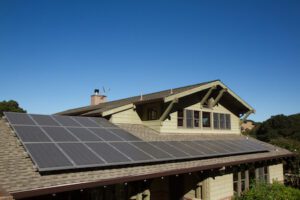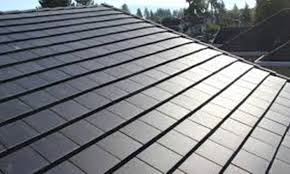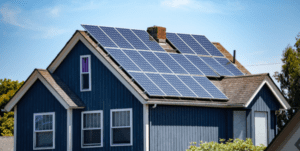Average Cost of Solar Panels: Top 10 States for Solar in the U.S.

The solar industry in the United States is booming. In 2021, a new solar energy project was installed every 60 seconds, and solar accounted for almost half (46%) of all new generating capacity last year. There is currently enough solar energy installed to power more than 23 million American households and it is projected that 13% of all homes in the U.S. will have a solar panel system by 2030.
COMPARE QUOTESIf you are a homeowner, it’s likely that you have given at least some thought to switching to solar energy. On top of the environmental benefits of going green, homeowners stand to save thousands of dollars on their energy bills when they install a solar system on their properties.

The average cost of solar panels will ultimately dictate whether homeowners make the jump to solar energy. There are many factors that determine the cost of solar panels, which we will highlight in this article. We will also highlight the top 10 states for solar energy by cumulative solar capacity and how 5Estimates.com can help you switch to solar for less.
What Is the Average Cost of Solar Panels In the U.S.?
As we have highlighted in the introduction, there are a number of factors that determine the exact cost of a solar panel system. The first factor to consider is the size of the solar panel system you choose to install. This will be dependent on the size of your property, your energy usage, and the number of people who live there.
As we will see below, location is another major factor. Considerations here include local market conditions, available state incentives, and the amount of sunlight your property receives. In addition to any state incentives, homeowners in the US can avail of the 26% federal solar tax credit.

The type of solar panel system that you choose is another factor. There are 3 main types of solar panels—Tier 1, Tier 2, and Tier 3. Though they are more expensive upfront, Tier 1 systems are the recommended option as they have the lowest degradation rate and produce the best output.
In the U.S., the cost of a 5 kW solar system (after applying for the federal tax credit) is approximately $10,000 to $13,000. This represents excellent long-term value for homeowners looking to save on their energy bills.
COMPARE QUOTESTop 10 States for Solar in the U.S.
In this section, we will look at the top 10 states for solar based on the cumulative amount of solar capacity that has been installed through 2021. We will highlight the number of homes currently supplied by solar in these states and the incentives that help homeowners make the switch to solar energy.
1. California
It should come as no surprise that California is leading the way for solar energy in the U.S (and by quite some distance, too). Approximately 34,950 megawatts of solar capacity have been installed in this sun-soaked state, which is enough to supply electricity to more than 10.3 million homes.
If we take Los Angeles as an example, there is an average of 284 sunny days per year, well ahead of the national average of 205 days. While California no longer offers a state incentive for solar energy systems, it has enacted a property tax exemption for homes with solar panel systems installed.
2. Texas
In a very distant second place is the state of Texas, with 13,845 megawatts of solar capacity installed to date. The equivalent number of homes supplied by solar energy in the Lone Star State is 1.7 million.
While Texas does not offer a statewide rebate program for solar systems, the year-round sunshine makes it one of the most attractive parts of the U.S. for solar installations.
3. Florida
Rounding out the top three is Florida, which has installed 8,206 megawatts of solar capacity through 2021. This is enough solar energy to power more than 1 million homes in the aptly-named Sunshine State.
Unfortunately, there is also no dedicated statewide solar rebate program in Florida. The cities of Jacksonville and Orlando, however, do offer rebates for solar battery backup. Homeowners can get up to $4,000 back in Jacksonville and up to $2,000 in Orlando.
4. North Carolina
Just behind Florida in fourth place is North Carolina, with 7,811 megawatts of solar capacity. This is likewise sufficient to power more than 1 million homes in the state.
The Tar Heel State has approximately 213 sunny days per year and offers a property tax exemption to cover the additional value of your home after installing a solar system.
5. Arizona
In fifth place is Arizona, which has installed 5,644 megawatts of solar capacity through 2021. This is equivalent to supplying almost 950,000 homes with electricity generated by solar energy.
There is good news for homeowners in Arizona, as there exists a statewide solar tax credit. This tax credit covers 25% of the total system cost, up to $1,000. In addition to the 26% federal solar tax credit, this represents excellent savings on the upfront cost of installing a solar system.
6. Nevada
Nevada currently sits in sixth place on the list, with 4,511 megawatts of solar capacity installed. This is enough to power more than 813,00 homes.
While there is no dedicated solar incentive program in the state, certain manufacturers do offer their own solar rebates to help with the upfront cost of installing a solar system.
7. Georgia
Swinging back further to the east, we go to Georgia where there is currently in the region of 4,268 megawatts of solar capacity. This is enough solar power to power 542,000 homes in the state.
While there are a number of states offering their own incentives in addition to the federal tax credit, Georgia is not currently one of them.
8. New Jersey
While New Jersey’s cumulative solar electricity capacity is less than Georgia’s at 3,853 megawatts, this is sufficient to power close to 660,00 homes in the Garden State.
While there is no solar rebate program in the state, homeowners can save through the New Jersey TREC (Transition Renewable Energy Certificate) Program.
9. Virginia
In ninth place currently is Virginia, with 3,761 megawatts of solar capacity. This is enough to power almost 460,000 homes. Again, while there is no dedicated state rebate program for solar installation, certain manufacturers do offer their own solar rebates.
10. Massachusetts
Rounding out the top 10 is Massachusetts, in the New England region to the northeast of the country. Through 2021, 3,607 megawatts of solar capacity have been installed, sufficient to power 653,000 homes in the state.
Massachusetts does offer a state solar tax credit of 15%, up to a maximum value of $1,000. The state also offers a SMART solar program to further incentivize residents to make the switch to solar energy.
What Are the Benefits of Solar Panel Systems?
For most homeowners, the primary benefit of installing a solar panel system on their property will be cost savings. Over the 25-plus year lifespan of a solar system, homeowners can expect to save upwards of tens of thousands of dollars on their energy bills. With property care and regular maintenance, solar panels can effectively generate clean energy for 40 to 50 years.

Solar panels also help to increase the value of properties, which we have alluded to in this article. This is because installing a solar panel system is regarded as a home improvement project. Homes with a solar system sell for around 4% more than comparable homes without a solar system.
If you have already purchased an electric vehicle (EV) or are planning to, it’s worth highlighting that EVs pair excellently with solar panel systems. This is because charging an EV using solar panels at home is more affordable than using grid electricity or a public charging station.
The environmental benefits of switching to solar energy include:
- Reduces air pollution
- Reduces water usage
- Helps to combat climate change
- Reduces our dependence on fossil fuels
- Solar panels do not emit greenhouse gases
Making the switch to solar panels also helps to support the more than 230,000 people employed in the solar industry in the U.S. today.
Discover the Benefits of Solar Energy for Yourself
The bottom line is that the average cost of solar panels in the U.S. depends on a range of factors. The good news is that the cost of installing solar panels has declined by 4% in the past 5 years alone. In the long term, it is clear that solar panels are an excellent investment for homeowners across the U.S.
Here at 5Estimates.com, we are dedicated to helping you find solar companies near you and compare local costs, alternatives, and options for installing solar panels. Get free solar quotes now from companies in your area and see how easy it is to make the switch to solar energy.
COMPARE QUOTES

Leave a Reply